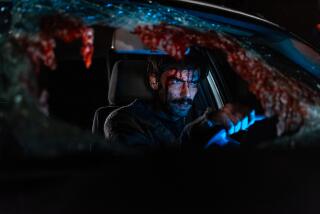Trying to Scare the Devil Out of the Young
- Share via
The American Cinematheque’s Alternative Screen showcase at the Egyptian presents tonight at 7:30 George Ratliff’s “Hell House,” which documents how the Trinity Assembly of God Pentecostal Church in Dallas has turned Halloween into an opportunity to terrify teens onto the path of righteousness. This is an authentic slice of Americana, a sometimes unintentionally amusing but overall disturbing conflation of primitive hellfire-and-damnation religious convictions and up-to-the minute technology.
Trinity Assembly, which also has its own school, devotes considerable time and resources into building a large, substantial compound that is a grim parody of the old boardwalk fun house. Teens and some older types sit in bleachers to watch a series of Grand Guignol tableaux illustrating the horrors of bleeding to death from a botched abortion; dying from AIDS; taking drugs at a rave and ending up raped and suicidal; and being mowed down by a drunk driver. (The year before, Hell House re-staged the Columbine massacre.) The vignettes are staged like Victorian melodramas, but the settings, props and special effects are worthy of Hollywood and have a lurid, virtual reality aura. (It’s impossible not to speculate about what’s really going on inside those performers who play baddies and their victims with such fervor.) In its first decade, Hell House, which was started in 1990, has attracted a reported 75,000 attendees and 15,000 converts or recommitments to Christianity.
There’s something to be said for a church making a bold, all-out attack on issues that endanger teens and many others everywhere. It’s the extremely narrow and simplistic approach to the problems, steeped as it is in anti-abortion and homophobic attitudes for starters, that’s scary. Indeed, the entire undertaking operates on fear: It’s either take Jesus Christ as your personal savior or burn in hell. At the end of the Hell House performance, a church member assures those exiting through a foyer that what they’ve just witnessed isn’t meant as a scare tactic--and then gives them six seconds to decide whether to proceed through a certain door. Those who go through it have made the leap of faith toward salvation; those who hesitate remain among what the church regards as the “walking dead.”
Ratliff has been shrewd enough to win the church’s trust, honorable enough not to betray it, and smart enough to trust in the power of his material without editorializing. The Egyptian is at 6712 Hollywood Blvd., Hollywood. (323) 466-FILM.
*
While the horrors of Hell House are fake, the challenges facing the sheltered young people of Lucy Walker’s eye-opening “Devil’s Playground” (Sunset 5 in West Hollywood, Saturday and Sunday at 10 a.m.) are all too real. It is surely not widely known that when Amish children turn 16, they enter a six-year period of life called “Rumspringa,” or “Running Around.” Until they reach that age, they remain in a strict, religious world virtually devoid of modern conveniences--no electricity, no cars, no movies, not even buttons--and they wear the severe uniform clothing of their 300-year-old community.
At 16, they are free to enter the outside world until they decide whether they want to return and join the church and community for life, committing themselves to the austere existence in which they have been raised. Is it any wonder that some go wild like the proverbial preacher’s kid, especially in today’s dangerously temptation-laden world?
In fact, the most striking of the several young people Walker tracks for two years with such unobtrusiveness, depth and perception is a preacher’s son, Faron Yoder, whose real-life teen odyssey is the stuff of fictional movies. He has at 18 moved from his home in an Indiana Amish community to a nearby trailer with another Amish youth, Gerald Yutzy, and they work in a trailer factory. Gerald is content with the novelty of having “500 channels of DirecTV, a stereo, Nintendo and a fridge full of beer.” Faron, however, is using and dealing crack, and faces the choice of ratting on his suppliers or receiving a possible 25-year prison sentence.
By contrast, Velda Bontrager, now 23, had returned home and was making her wedding dress when she came to realize that the freedom and choice she had enjoyed during her Rumspringa had put her off the Amish way. Even though her fiance was unable to follow her to the outside world, she went ahead and faced the traditional shunning by family and friends so that she could try to live a fuller life--and even dream of the impossible: going to college (schooling stops for Amish kids at the eighth grade in the belief that further education breeds pride). Both Faron and Velda are clearly more intelligent and capable of independent thought than their friends. Indeed, Faron is notably articulate and well-spoken, while most of his contemporaries routinely use double negatives and have limited vocabularies.
Walker respects the ordered, deeply spiritual communal existence of the Amish. Indeed, the appeal of a secure, ordered existence remains so strong that the rate of returning Amish young people is 90%, an all-time high.
The second offering in the Laemmle Theaters’ Documentary Days series, “Devil’s Playground,” screens at 11 a.m. Aug. 31 through Sept. 2 at the Monica 4-Plex, Santa Monica, (310) 394-9741; Sept. 7-8 at the Playhouse 7, Pasadena, (626) 844-6500; and Sept. 14-15 at the Fallbrook, West Hills, (818) 340-8710.
*
Among the films screening at the Egyptian in the final week of the American Cinematheque’s third annual Festival of Fantasy, Horror & Science Fiction is the fairly obscure 1969 picture “The Mind of Mr. Soames” (Sunday at 4 p.m.). It is of primary interest for the excellent performance in the title role by Terence Stamp, whose career has enjoyed a steady resurgence since “The Adventures of Priscilla, Queen of the Desert” (1994), in which he played a fearless transsexual. This Columbia production is a good, offbeat, well-directed (by Alan Cooke) British science-fiction film that might have been even better had its basic premise been carried through with more imagination. Stamp’s Soames is a man who is “born” at the age of 30. Fed intravenously and massaged regularly to keep his muscles from atrophying, he is at last released from his lifelong coma by the wizardry of American brain surgeon Robert Vaughn. With his boyish, even angelic face, Stamp is perfectly cast and altogether convincing.
So effective is Stamp at portraying all that pertains to Soames’ discovery of self and others at such an advanced age that it’s unfortunate the filmmakers settled for drawing its dramatic conflict from a contrived-seeming clash between Vaughn and Nigel Davenport, who plays the hard-nosed head of the institute where Soames is kept. “The Mind of Mr. Soames” will be presented with a new 35-millimeter print. Its producer, Max Rosenberg, will discuss the film after the screening.
*
The Los Angeles County Museum of Art is presenting this weekend two of the greatest films of Kenji Mizoguchi, a giant of classic Japanese cinema. Screening Friday at 7:30 p.m. is his exquisite, 16th century ghost story, “Ugetsu” (1953), in which a humble potter (Masayuki Mori) is captivated by the beautiful but spectral Machiko Kyo. The potter’s wife is played by Kinuyo Tanaka, who stars in the title role of “The Life of Oharu” (1952). (323) 857-6010.
*
To mark the 76th anniversary of the death of Rudolph Valentino, the Silent Movie Theatre is presenting one of his best movies, “Blood and Sand” (1922), directed by “Ben-Hur’s” Fred Niblo. “Blood and Sand” screens Friday and Saturday at 8 p.m. and Sunday at 1 and 4 p.m. at the theater, 611 N. Fairfax Ave., L.A. (323) 655-2520.
More to Read
The biggest entertainment stories
Get our big stories about Hollywood, film, television, music, arts, culture and more right in your inbox as soon as they publish.
You may occasionally receive promotional content from the Los Angeles Times.










